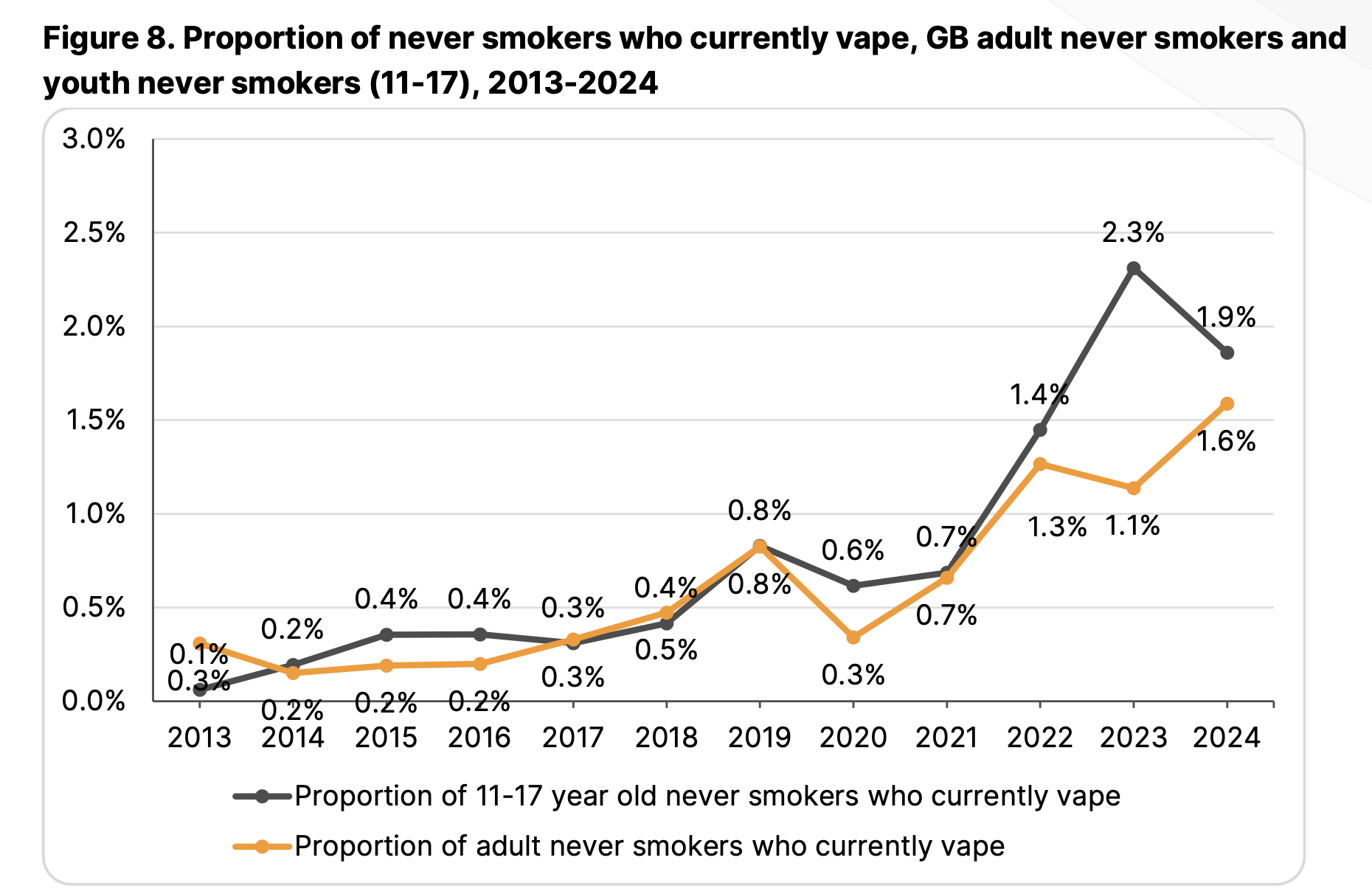Action on Smoking and Health has released its latest findings about the use of vapes over the last 12 months in Great Britain. The anti-smoking charity says the factsheet analyses how behaviour and attitudes has changed. The survey is conducted by YouGov in Spring each year and is targeted at 11–18-year-olds.
Action on Smoking and Health recently reiterated its support for the Tobacco and Vapes Bill and, through the stats it highlights, it seems determined to ignore the good news buried in its findings. In following articles, we will go on to hear from Action on Smoking and Health and public health experts.
ASH states that patterns of use are currently:
- In 2024, 18% of youth aged 11-17 had tried vaping, amounting to 980,000 children, which isn’t significantly different from the rate in 2023 (20%). Over half of these (53% of ever vapers, or 9.5% of all youth) had only tried once or twice (520,000 children aged 11-17), with 3.0% of all youth vaping less than once a week (160,000 children), 4.2% more than once a week (230,000 children), and the remainder (1.3%) saying they no longer vape.
[Rewind]
[Play]
Just 4.2% vape “more than once a week”.
[Record scratch]
[Rewind]
[Play]
Just 4.2% vape “more than once a week”.
ASH is stating that frequent use of vapes in teens has not increased.
Despite the presence of single-use products, despite the presence of flavoured eliquids, despite claimed ‘marketing to kids’, despite the designs on packaging and TikTok influencers - absolutely no increase in use.
Now, either this claimed marketing to children doesn’t work or the companies allegedly engaging in it are doing it terribly for there to be no increase in teen vaping; all of which would indicate that the only reasons some teens are vaping is that they would have been predisposed to smoking and vapes have offered a safer way to rebel.
ASH continues:
- In 2024, 7.2% (390,000 children aged 11-17) currently vaped compared to 5.1 (280,000 children) who currently smoked. There have been more children vaping than smoking since 2021 (Figure 7). In 2024, 2.8% (150,000 children) are dual users, who both vape and smoke. Ever smoking has increased significantly since 2023 and is now the same as ever vaping at 18%. Smoking rates are now back up to pre-pandemic levels after seeing a decline during lockdowns.

Advocates for harsher restrictions on vaping will point to this and claim that vaping has led more teens into smoking. The counter to this is that smoking rates have risen due to the fear-mongering about vaping – something that is proven to be safer than smoking and would be a better thing for risk takers to initiate rather than tobacco – something ASH says it is opposed to.
The argument for ASH’s current position on flavour bans comes from them saying, “Among never smokers the next most popular reasons [after just giving it a try] for vaping were ‘other people do it so I join in’ (18%) and ‘I like the flavours (11%).”
ASH then confirms: “For the second year in a row most children aged 11-17 (58%) wrongly believe that vaping is about the same or more harmful than smoking.”
So, where do teens get their vapes from? ASH says:
- Being given them (54%)
- From shops (48%)
- Informal purchase (27%), of which 13% said they got them from the internet
The types of vapes they used included:
- 54% used a disposable vape (down from 69% in 2022)
The most popular brand they used was:
- Elf Bar
The most popular flavour they used was
- Fruit
ASH says:
- Fruit flavours are popular with 47% of adults and 59% of children
- Children are more likely than adults to choose sweet flavours (16%)
- Children are less likely to choose tobacco (2.7%)
- Children are less likely to choose mint/menthol flavours (6.9%)
Again, ASH will ignore the benefit of flavours for adults in the belief that banning popular flavours will drive down teen vaping…and therefore smoking…ignoring that this won’t work, and the gateway effect doesn’t exist.
Planet of the Vapes has covered multiple studies showing that restricting flavours has two outcomes: firstly, it does drive down vaping rates – but, importantly, it drives up smoking rates.
ASH states: “In conclusion, although our survey suggests the rapid rise in youth (aged 11-17) vaping since the pandemic has stabilised in 2024, it is not yet clearly declining. And although the vast majority (81%) of children aged 11-17 have never tried vaping, over a third of those who have tried vaping have never smoked. Furthermore, children’s awareness of promotion continues to rise. The big increase in the use of disposable products has happened concurrently with higher levels of youth use from 2021 to 2023.”
A précis might suggest fears of a teen epidemic have been overblown, knee-jerk action might harm adult smoking quit attempts, and the removal of flavours in conjunction with raising prices through taxation risks driving ex-smokers back to tobacco.
References:
- Use of vapes (e-cigarettes) among young people in Great Britain, July 2024 - https://ash.org.uk/uploads/Use-of-vapes-among-young-people-in-Great-Britain-2024.pdf?v=1722505432
Dave Cross
Journalist at POTVDave is a freelance writer; with articles on music, motorbikes, football, pop-science, vaping and tobacco harm reduction in Sounds, Melody Maker, UBG, AWoL, Bike, When Saturday Comes, Vape News Magazine, and syndicated across the Johnston Press group. He was published in an anthology of “Greatest Football Writing”, but still believes this was a mistake. Dave contributes sketches to comedy shows and used to co-host a radio sketch show. He’s worked with numerous start-ups to develop content for their websites.


-listing400.jpg)




